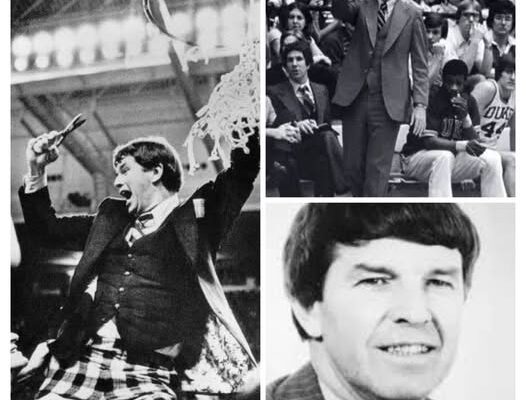In the annals of college basketball, the name Duke University conjures images of national championships, legendary coaches, iconic players, and a relentless pursuit of excellence that has defined the program for decades. The indelible mark of Mike Krzyzewski, with his five national titles and a coaching career spanning over 40 years at the helm, casts a monumental shadow. Yet, beneath the towering edifice of the Krzyzewski era lies a foundational, often overlooked, chapter—a period of quiet but profound transformation orchestrated by a man whose legacy deserves far greater recognition: Bill Foster, the forgotten architect who truly resurrected a sleeping giant.
Foster’s tenure existed before the banners began to proliferate in Cameron Indoor Stadium, before “Coach K” became synonymous with Duke basketball, and definitively before the Blue Devils cemented their status as a household name in NCAA basketball. While the Mike Krzyzewski era is rightly celebrated for its supremacy and enduring legacy, fewer people realize that Duke’s comeback actually started in the middle of the 1970s, under Foster’s cool, collected leadership. It was his understated brilliance, his strategic acumen, and his unwavering commitment to rebuilding a faltering program that laid the essential groundwork for everything that followed.
When Bill Foster was hired as head coach in 1974, he inherited a Duke program that had become utterly obsolete. The once-proud Blue Devils, who had reached national prominence in the early 1960s under Vic Bubas, had fallen into a deep decline. The 1970s had been a period of mediocrity, marked by losing seasons, waning fan interest, and a palpable sense of resignation around the program. Duke, a university renowned for its academic rigor, found its basketball team struggling to compete even within the Atlantic Coast Conference (ACC), arguably the toughest conference in the nation. It was a program adrift, lacking direction, talent, and the competitive fire that had once defined it. This was the landscape Foster stepped into – a challenge that would have daunted many, but one he approached with quiet confidence and a clear vision.
Foster arrived in Durham having achieved success at the University of Utah, where he revitalized another struggling program. His reputation was built on his ability to recruit effectively, teach fundamental basketball, and instill a disciplined yet potent offensive system. He was not a showman; his charisma was found in his tactical intelligence and his genuine belief in the potential of his players. This understated approach, however, belied a fierce determination to return Duke to relevance.
The early years of Foster’s tenure were characterized by the arduous process of rebuilding from the ground up. This meant painstaking recruitment, convincing talented high school players that Duke, despite its recent struggles, was a program on the rise. Foster’s keen eye for talent and his persuasive, direct communication style began to bear fruit. He landed key recruits who would form the core of his groundbreaking teams. Among them were players who would become synonymous with Duke’s revival, talents like Jim Spanarkel, Mike Gminski, and Gene Banks – a trio that would become the backbone of a team that captivated the nation.
Beyond recruiting, Foster implemented a structured and intelligent offensive system. He emphasized crisp passing, intelligent cuts, and efficient shot selection, moving away from the more chaotic, often individualistic, play that had plagued Duke in the preceding years. Defensively, his teams were disciplined and aggressive, focusing on fundamental principles and frustrating opponents with their collective effort. This systematic approach, coupled with the growing talent on his roster, began to yield tangible results.
The turning point under Foster’s leadership arrived dramatically in the 1977-78 season. After a period of gradual improvement, the Blue Devils exploded onto the national scene. They entered the NCAA Tournament as a surprise contender, embarking on an improbable run that captivated the basketball world. With a blend of seasoned veterans and burgeoning stars, Foster’s team, characterized by its fluid offense and tenacious defense, defied expectations at every turn. They upset highly ranked teams, showcasing their cohesion and grit.
The highlight of this miraculous season was their march to the NCAA Championship game. Though they ultimately fell short against a powerful Kentucky team, their journey was nothing short of miraculous. It wasn’t just the wins that mattered; it was how they won. They played with a swagger, a newfound confidence that had been absent for years. Cameron Indoor Stadium, once a respectable but quiet venue, was transformed into a cauldron of fervent energy, rekindling the passionate Duke fanbase. This incredible tournament run put Duke basketball back on the national map, drawing unprecedented attention and excitement to the program.
Foster’s impact extended beyond just that single magical season. He had fundamentally changed the perception of Duke basketball. He had proven that the program could not only compete with the nation’s elite but could also attract and develop top-tier talent. He instilled a professional ethos and a commitment to excellence that resonated deeply within the athletic department and the university as a whole. He elevated the program to a level where it was once again a destination for top recruits, a place where aspiring college basketball stars could envision themselves succeeding both academically and athletically.
While Foster’s tenure at Duke was relatively brief – he departed for the University of South Carolina in 1980 after six seasons – his legacy is profound and undeniable. He achieved what many thought impossible: he took a dormant program, dusted it off, and meticulously rebuilt it into a national powerhouse. He laid the foundation of success and legitimacy that made the Duke head coaching job one of the most desirable in the country. It was his hard work in the trenches, his strategic vision, and his success on the court that created the fertile ground for Mike Krzyzewski’s subsequent unprecedented run of dominance.
Without Bill Foster’s pivotal rebuilding efforts in the mid-1970s, it is entirely plausible that the Duke program would have remained mired in mediocrity for far longer, and Coach K might have inherited a far more challenging, less attractive situation. Foster’s period as head coach was the indispensable bridge between obscurity and immortality. He proved the program’s potential, revived its spirit, and established the framework of recruiting and on-court discipline that would become hallmarks of Duke basketball for decades to come.
So, as fans reflect on the unparalleled glory of Duke basketball, it’s essential to remember the man whose cool, collected leadership ignited the spark that became a raging inferno of success. Bill Foster, the forgotten architect, deserves his rightful place in the pantheon of Duke legends, for it was under his watch that Duke’s comeback truly began, paving Duke’s road to greatness long before the banners, long before the household name, and long before the dynasty took full flight. His untold story is a testament to the power of vision, hard work, and the quiet determination to resurrect a sleeping giant.



